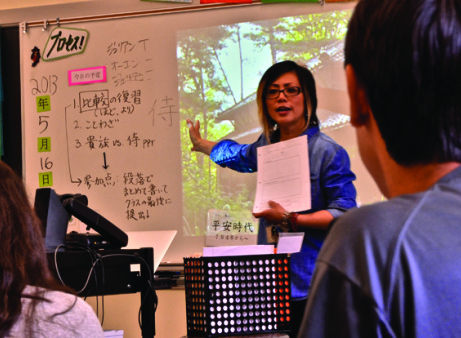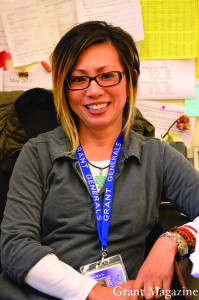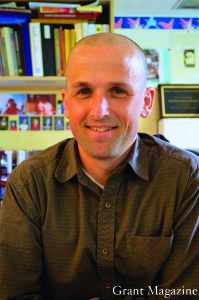
Last month, after making some difficult budget-driven decisions about program offerings for next year, Grant High School Principal Vivian Orlen pulled up her e-mail, only to be bombarded by countless accusations from concerned future-Grant parents.
The Japanese Magnet Program at Grant had been cut and those parents were not happy.
On the surface, the program known as JMP, hosted by Richmond Elementary, Mt. Tabor Middle School and Grant, is a gem for Portland Public Schools. Students are educated in an immersion environment as they explore the language and culture of Japan. The program offers numerous opportunities: trips to Japan, extensive research projects outside the classroom, and a tight-knit, supportive community from kindergarten to high school graduation.
Initially, budget cuts in April meant the end of JMP classes at Grant. At the same time, the Latin program at Grant is being phased out and funding for the English Language Learners class was in jeopardy.
The cuts, though, raise questions about the effectiveness of the Japanese classes at the high school level, and point to the difficulties facing Grant and the district on what programs to cut.
At Richmond and Mt. Tabor, the program is nationally recognized and thrives. But in high school, the JMP is under-enrolled compared to other world languages, and many of its students lose interest and proficiency, dropping out of the program.
The program is full immersion at the elementary school level – which means 50 percent or more of the instruction is in Japanese. During middle school, students drop to one third of their day in Japanese. Once at Grant, JMP students are only offered one Japanese class.
Grant Japanese teacher Kazuko Page – who has been with the JMP since it started at Grant in 1998 – says the cuts were unfair: “Parents were told to commit themselves to K-12 when they chose the program and enrolled their kindergarteners. I thought (getting rid of JMP) was beyond the school’s decision.”
She questions where Grant’s priorities lie. “When we decide to cut something, do we look only at enrollment number?” she asks. “Or do we look at the quality and diversity?”
Orlen says she has been concerned about the JMP since she came to Grant three years ago. Previously, the program had been partially funded by a Foreign Language Assistance Program grant. But the FLAP grant ends this year. “I was struck by the fact that there didn’t appear to be a plan B in place within our district to figure out how we were going to support the program at the sunset of the grant,” says Orlen.
The combination of the FLAP grant ending and the tightened budget in mid April forced Orlen and Vice Principal Kristyn Westphal, who is in charge of curriculum, to make some tough decisions. Grant would not be able to afford the JMP and the KISO program – introductory Japanese classes available to both neighborhood and JMP students with a lower proficiency level.
School administrators say the reality is that with the current state of funding, either you have fewer languages but are able to offer them up through the college level – a choice Orlen says most students and parents prefer – or you offer more languages like intro Japanese and Latin, but only at lower levels.
When deciding what programs to cut, Westphal says she looks at the enrollment numbers for the classes students have forecasted for. Compared to the other languages offered at Grant (Spanish and French), the JMP is significantly smaller. There are 75 current Grant students forecasted to take a JMP class next year, with 24 entering JMP freshmen. That’s down from 36 this year. Sixteen entering freshmen have forecasted for the KISO classes.
In comparison, the Spanish program at Grant currently has 416 students while French has 190.
 Grant Japanese teachers Kimiko Lupfer and Kazuko Page both knew the KISO program would be on the line once the FLAP grant was gone, but they were surprised when they were told both programs would be cut. “I was in shock and confused,” Page says. “It showed me how the district and school really did not know what the program is all about and how it worked.”
Grant Japanese teachers Kimiko Lupfer and Kazuko Page both knew the KISO program would be on the line once the FLAP grant was gone, but they were surprised when they were told both programs would be cut. “I was in shock and confused,” Page says. “It showed me how the district and school really did not know what the program is all about and how it worked.”
Both Page and Lupfer say some of their students were devastated about the JMP cuts. Junior Allison Little, president of the JMP student council Seitokai, remembers hearing the news from Page and being “so mad at first. I pretty much ran around the entire school that day,” she says.
Soon the halls of Grant were filled with posters and students clad in t-shirts supporting the program.
Many parents of JMP students were angry that a program they and their kids had invested in would be compromised. Although Grant’s administration believes parent advocacy is important, “I never think it’s in the best interest of the school when special interest groups are only advocating for their special interests,” says Orlen. She says some of the parents contacting her were “trying to say that one world language is more important than another – it’s not a useful or constructive argument.”
However, additional resources were found, and the JMP and KISO programs were restored. Orlen says the key to finding the additional teacher positions was the Northeast, Southeast and Wilson-Lincoln Parents Coalitions that she says is “a really smart and organized handful of parents in this city who really fought for all schools, all students, all programs.”
With the program now stabilized for another year, Orlen and others will examine the future of JMP as a whole.
For many JMP students, the program has given them cultural opportunities and skills they wouldn’t have access to otherwise. For Little, the JMP gave her the chance to travel and broaden her cultural horizons. Junior Sara Onitsuka appreciates the educational challenges and global opportunities of JMP – she is the first and only student representative on the Sapporo-Portland Sister City Association board. The JMP provided Rintaro Yano a comfortable place to ease the transition when he moved here from Japan in fifth grade. Senior Karlee Hoff says simply: “You could send me to Japan for a year and I would be fine.”
When Lupfer first started teaching at Grant four years ago, she was shocked at how deeply acculturated the students were with the Japanese language and culture, even though it wasn’t part of most students’ heritage. She says the goal of the JMP is to raise global citizens who are ready to become future leaders of the community. “My goal has been being a bridge between cultures,” Lupfer says. “That’s why it’s really fun for me to see future bridges here. It’s a lifelong journey.”
On paper, the JMP high school program is impressive. About 80 percent of JMP students who took the AP exam passed with a three or above on the five-point scale. According to the American Council on the Teaching of Foreign Languages, the national average retention rate for high school language programs is that 60 percent continue on to the next year. For the JMP in high school, the retention rate ranges from 70 to 90 percent each year.
After 13 years in the JMP program, some students continue to pursue Japanese. The University of Oregon has a Global Scholars Program that allows JMP students to continue studying Japanese at a higher level. But many who started the program graduate without the special JMP diploma.
Grant senior Keenan Grobart started JMP in kindergarten, but dropped out after the first semester of his junior year. He loved learning Japanese in elementary school, but his interest started to wane as he reached middle and high school.
Grobart says his friends who are still in JMP sometimes ask him why he didn’t just stick it out for the last year. “But I don’t think I could’ve,” he says, “I would have been miserable. I didn’t enjoy learning Japanese anymore.”
Rachel Seeman – who graduated from Grant in 2010 and is currently a junior at Stanford University – is a strong supporter of the Japanese program, but only through eighth grade. The program falters in high school, she says.
She says in high school the JMP “is currently lacking in enough classroom time and quality resources for language improvement. If the district is deciding where to allocate funds, I believe that they should go to programs like ESL first, and then language programs open to the public, not the small subset of JMP-ers.”
Grobart stuck with the program after middle school because he didn’t want to go to his neighborhood school, Franklin. All of his friends in the JMP program were going to Grant and he didn’t want to split from them. “You’ve been with them for nine years. They’re basically your family,” he says.
Many JMP students interviewed share this sentiment and said some of the best things they’ve gotten out of the program were the friends they’ve made and the sense of community, and they highlight the two trips to Japan during fifth and eighth grade as their fondest memories.
Although Grobart says his parents didn’t enroll him in the program specifically so he could get into Grant, members of the community have expressed concern that this is a motivation for some families. Because JMP is a magnet program, JMP students who live outside of Grant’s boundaries get to attend Grant instead of their neighborhood school. Even if a JMP student drops out of the program after freshman year, they are not forced to return to their neighborhood school.
Grant alumnus Cameron Dieter, who graduated from the JMP last year and currently attends Beloit College in Wisconsin, admits some of his peers saw the JMP as a class that created a pathway to a better school. “That’s not right, but that’s what we thought,” Dieter says. “I don’t think parents are thinking about that when they put their kids in the JMP, but they’re definitely thinking about that when their kids stay in the JMP.”
Even with the advantage of getting into Grant, both Dieter and Grobart saw their class sizes shrink through middle and high school. Dieter says his largest JMP class was around 63. Only 19 of them graduated with JMP diplomas. Although the losses are not all attributed to the program itself – some kids move, go to private schools or leave for other reasons – many voice that compared to middle school, Grant’s Japanese program is weak.
Page claims one of the reasons students drop out of the program is because in high school students move up levels based on proficiency, not social promotion. If students fall behind, they can’t continue with their classmates and may sometimes be placed in the KISO courses with the “neighborhood kids.”
Seeman, Grobart and Dieter all agree their Japanese language skills either flat-lined or declined once they reached high school, and none of them use their Japanese anymore. “Everyone is at their peak coming out of eighth grade,” says Dieter, who attributes this to the intensive capstone research project, the trip to Japan and what he describes as an exceptional eighth-grade Japanese teacher, Matt Bacon-Brenes.
 Bacon-Brenes, who has been teaching for 24 years – 10 of those with JMP at Mt. Tabor – has always had a passion for teaching and a love for Japanese language and culture.
Bacon-Brenes, who has been teaching for 24 years – 10 of those with JMP at Mt. Tabor – has always had a passion for teaching and a love for Japanese language and culture.
While there isn’t as much energy around learning Japanese in the United States as there was in the 1980s when Bacon-Brenes was in school, “Japan is still the third largest economy, people forget, a major trade partner of Oregon and more importantly, there is a large community on the West Coast,” he says.
Bacon-Brenes has always appreciated and enjoyed Spanish but he says he believes Japanese is equally important. “On the whole, we take kind of a head-in-the-sand approach in the U.S.,” he says. “It’s important to expand our global sense and show that we value all people.”
Orlen agrees with Bacon-Brenes on the importance of all world languages, but notes the cuts at Grant are not about not valuing Japanese. “The issue is that it’s really hard to recruit non-immersion students to take Japanese,” she says. Many freshmen arrive at Grant with middle school experience in French or Spanish and naturally want to continue building on those skills, hence contributing to the under-enrollment of Japanese classes.
Dieter says his parents put him in the JMP as a kindergartener because studies have shown learning a language young is good for your brain and they thought being bilingual would give him a leg up when it came to applying to college and the job market.
Seeman was put in the program so she could communicate with her Japanese grandparents, “but I never made the active decision to learn the language,” she says.
Lupfer acknowledges that this might be another reason students drop out. “Parents put them in, so naturally freshman and sophomore year are the times when students start thinking about their life and their own identity. Is it really mine? Do I really want to do this?”
Would an increase in immersion improve Japanese interest at Grant? When the JMP first received the FLAP grant, Grant was able to provide two Japanese classes to JMP students. But the JMP community met this change with resistance because it prevented students from taking other interesting classes Grant had to offer.
Dieter struggled to keep his Japanese grades high enough through his disinterest in the program, and ran a victory lap around the school when he found out he would be able to graduate with the JMP diploma. Rather than an opportunity to learn about a different language and culture, for Dieter, sticking with the JMP in high school was “more of a test of perseverance – a Japanese value called gaman: to endure the unendurable.”
Dieter says he wanted to prove to others and himself that he could do it. Today, he says he saw the cuts coming, and doesn’t think the program is worth funding beyond eighth grade. “From a selfish perspective, I benefited from the program, but that doesn’t mean it’s right. This program enables me to get to Grant, and gives me more opportunities because I’m at Grant.”
So what’s next for the JMP?
John Baumgardner has been a member of the JMP parent organization Oya No Kai for seven years and has two sons in the program at Grant. He points out that because of the huge demand for the JMP elementary program, Richmond has doubled the amount of students it’s accepting into its JMP kindergarten classes. This first “doubler class” of 100-120 students is currently in sixth grade at Mt. Tabor and will reach Grant in 2015. Baumgardner hopes this will help boost the JMP enrollment and support at Grant. He acknowledges the shortcomings of the high school program, and says it’s a long process to improve it. However, “it’s easier when the numbers are there,” he says.
Moving forward, Orlen says she envisions a future for JMP that involves having students experience real-world opportunities instead of spending four more years in a classroom, and says the high school program should be all about applicability. Both she and Oya No Kai members have explored partnering with local Japanese companies where juniors and seniors could do internships to work on and apply their language skills.
“A positive outcome is that I think now there is a group of parents whose kids have really invested in immersion and want to see the program strengthen here,” says Orlen. “Moving forward we will get to a better place in terms of defining what high school immersion should look like for our JMP kids.” ♦


